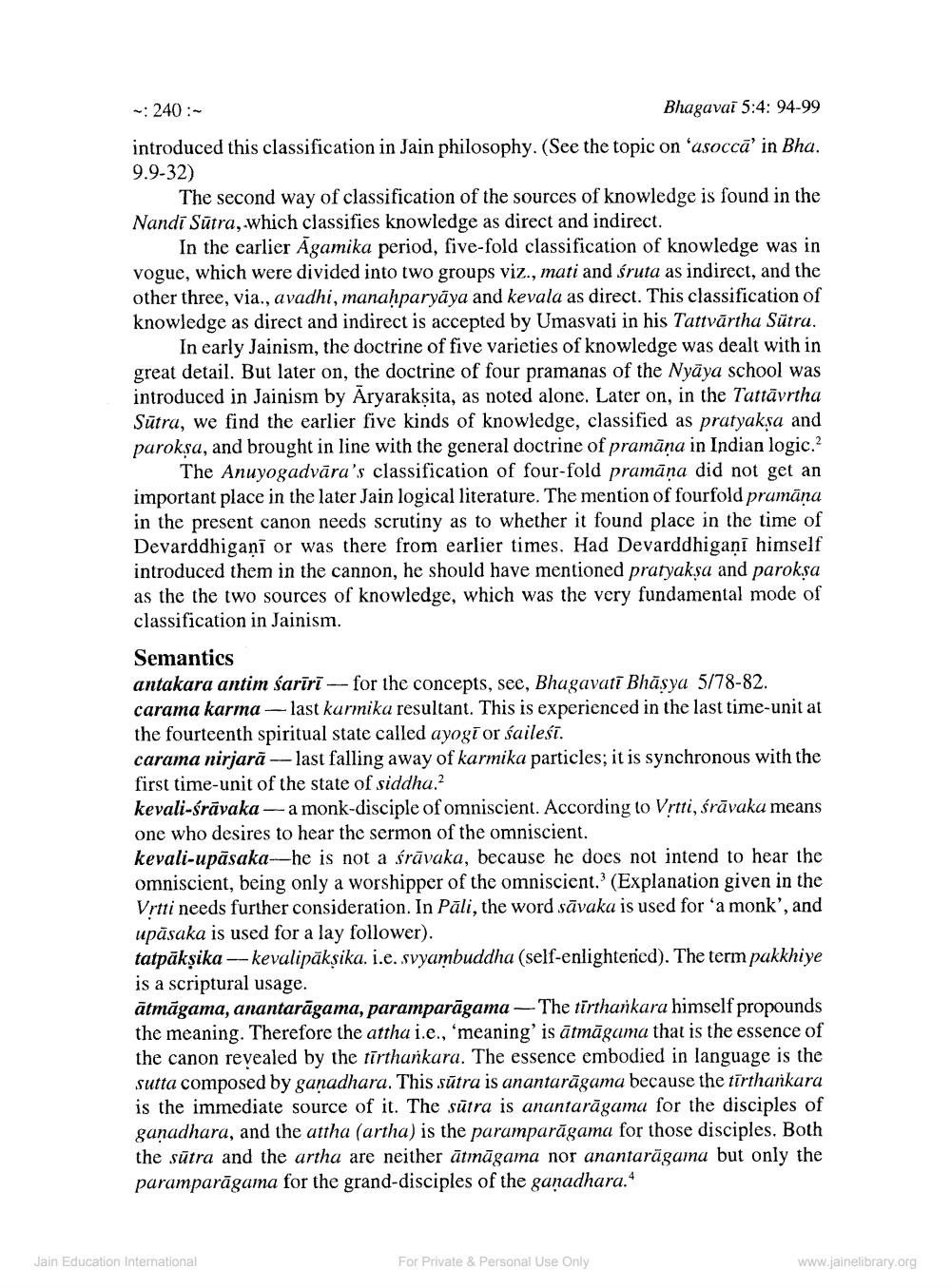________________
~: 240:~
Bhagavai 5:4: 94-99 introduced this classification in Jain philosophy. (See the topic on 'asocca' in Bha. 9.9-32)
The second way of classification of the sources of knowledge is found in the Nandi Sutra, which classifies knowledge as direct and indirect.
In the carlier Agamika period, five-fold classification of knowledge was in vogue, which were divided into two groups viz., mati and śruta as indirect, and the other three, via., avadhi, manaḥparyaya and kevala as direct. This classification of knowledge as direct and indirect is accepted by Umasvati in his Tattvärtha Sutra.
In early Jainism, the doctrine of five varieties of knowledge was dealt with in great detail. But later on, the doctrine of four pramanas of the Nyaya school was introduced in Jainism by Aryarakṣita, as noted alone. Later on, in the Tattävrtha Sutra, we find the earlier five kinds of knowledge, classified as pratyakṣa and paroksa, and brought in line with the general doctrine of pramāṇa in Indian logic.2
The Anuyogadvara's classification of four-fold pramāņa did not get an important place in the later Jain logical literature. The mention of fourfold pramana in the present canon needs scrutiny as to whether it found place in the time of Devarddhigani or was there from earlier times. Had Devarddhigani himself introduced them in the cannon, he should have mentioned pratyakṣa and paroksa as the the two sources of knowledge, which was the very fundamental mode of classification in Jainism.
Semantics
antakara antim sariri- for the concepts, see, Bhagavati Bhasya 5/78-82. carama karma-last karmika resultant. This is experienced in the last time-unit at the fourteenth spiritual state called ayogi or sailesi.
carama nirjară-last falling away of karmika particles; it is synchronous with the first time-unit of the state of siddha.2
kevali-śrävaka-a monk-disciple of omniscient. According to Vṛtti, śrāvaka means one who desires to hear the sermon of the omniscient.
kevali-upāsaka-he is not a śravaka, because he does not intend to hear the omniscient, being only a worshipper of the omniscient.' (Explanation given in the Vrtti needs further consideration. In Pali, the word sävaka is used for 'a monk', and upasaka is used for a lay follower). tatpäkşika-kevalipäkṣika. i.e. svyambuddha (self-enlightened). The term pakkhiye is a scriptural usage.
ātmāgama, anantaragama, paramparāgama-The tirthankara himself propounds the meaning. Therefore the attha i.e., 'meaning' is ātmāgama that is the essence of the canon revealed by the tirthankara. The essence embodied in language is the sutta composed by ganadhara. This satra is anantaragama because the tirthankara is the immediate source of it. The sutra is anantaragama for the disciples of ganadhara, and the attha (artha) is the paramparāgama for those disciples. Both the sutra and the artha are neither ātmāgama nor anantaragama but only the paramparagama for the grand-disciples of the ganadhara."
Jain Education International
For Private & Personal Use Only
www.jainelibrary.org




